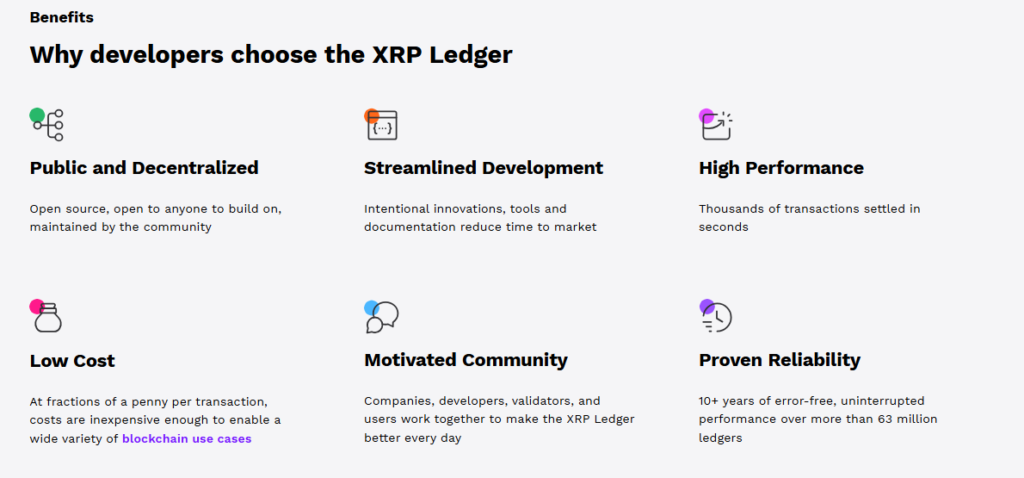XRP is the cryptocurrency that powers the XRP Ledger (XRPL) and has been a key player in the blockchain world, especially for cross-border payments and financial systems. Created by Ripple Labs, XRP stands out for its quick transactions, scalable design, and eco-friendliness, aiming to address the shortcomings of traditional finance. This piece will look into XRP’s tech advantages, how it’s being adopted, the challenges with regulations, and what it means for investors, giving a fair view of what lies ahead.
Tech Advantages: Speed, Efficiency, and Eco-Friendliness
The XRP Ledger uses a consensus protocol, which avoids the heavy energy demands of proof-of-work systems. This allows for incredibly fast transaction confirmations (within 3-5 seconds) and a capacity of 1,500 transactions per second, making it much quicker than Bitcoin (7 TPS) and Ethereum (15 TPS). Plus, the transaction fees are very low (just a few cents), making XRP perfect for small payments and large transactions.
Being energy efficient is another big plus. The XRPL’s consensus method uses very little energy compared to proof-of-work blockchains, which fits well with the growing focus on environmental, social, and governance (ESG) issues. This helps position XRP as a responsible choice, especially as more regulations look into the crypto industry’s carbon impact.

Adoption and Collaborations: Connecting with Traditional Finance
Ripple has teamed up with over 300 financial institutions, including big names like Santander, American Express, and SBI Holdings, showing that XRP has real-world applications. Through RippleNet, XRP acts as a bridge currency, making cross-border payments faster and cheaper, cutting costs by as much as 60% and reducing the need for nostro accounts.
Another area for growth is Central Bank Digital Currencies (CBDCs). Ripple’s CBDC Platform, tested by countries like Palau and Bhutan, shows how the XRPL can adapt to government-backed digital currencies. Success in this area might make XRP an essential part of the future of money.
Regulatory Challenges: The SEC Case and What’s Next
Ripple is currently facing a lawsuit from the SEC, which claims that XRP is an unregistered security. This is a significant hurdle. A positive resolution—like a settlement or clear rules—could encourage more institutions to get involved. On the flip side, ongoing uncertainty might scare off investors. Recently, Ripple has had some legal wins, including a decision stating that XRP isn’t a security in secondary sales, which has helped improve market sentiment, showing just how important clear regulations are for XRP’s future.
Broadened Use Cases: DeFi, NFTs, and Cross-Chain Connections
While cross-border payments are the main use for XRP, Ripple is also branching into decentralized finance (DeFi) and NFTs. The upcoming compatibility with Ethereum’s Virtual Machine will allow smart contracts on the XRPL, attracting developers from the DeFi space. Initiatives like XRP Toolkit and Sologenic’s NFT marketplace show the growing variety of projects in the ecosystem.
Efforts to improve interoperability, such as connections to Ethereum and Cosmos, further increase XRP’s usefulness, positioning it as a key player in a multi-chain environment.
Market Opportunities: Tapping into a Massive Potential
The global payments sector is worth about $120 trillion a year, offering a huge market. Even slight adoption by banks and payment companies could greatly increase demand for XRP. In addition, the potential market for CBDCs is expected to reach $213 billion by 2030, which presents more opportunities if Ripple’s platform takes off.
XRP has a set supply of 100 billion tokens, with around 48 billion currently available, which creates scarcity. Ripple’s system releases 1 billion XRP each month (with any unused amounts being re-locked), helping control inflation but needing close attention to avoid oversupply issues.
Investor Considerations: Past Trends and Future Possibilities
XRP’s price has shown the typical ups and downs of cryptocurrencies. After reaching a high of $3.84 in January 2018, it has hovered around $0.50 in late 2023. Looking ahead, possible return factors include:
- Regulatory Clarity: Winning the legal case might draw in institutional investors.
- Growth in Adoption: More usage in payments and DeFi could increase demand.
- Market Sentiment: XRP’s price often reflects broader market trends in crypto.
Experts believe that reaching its former high would require a market cap of about $200 billion (compared to around $26 billion in 2023), which could happen if adoption speeds up. However, competition from Stellar (XLM), SWIFT’s GPI, and stablecoins like USDC presents challenges.
Dog Coins in the USA: A Comprehensive Overview of Their Popularity
Risks and Challenges
- Regulatory Ambiguity: Ongoing legal battles or negative outcomes could hinder growth.
- Concerns about Centralization: Ripple’s control over XRP escrow raises questions about decentralization.
- Market Fluctuations: Economic factors and cycles in the crypto market can influence prices.
- Technological Risks: Security weaknesses or failure to keep up with advancements could decrease competitiveness.
Conclusion: Hope with Caution
XRP’s future depends on overcoming regulatory issues, expanding its use cases, and leveraging its tech strengths. Although there are risks, its alignment with institutional payment needs and eco-friendly trends gives it a unique spot in the blockchain world. For investors, XRP may offer high-reward prospects, balanced by volatility and external influences. As Ripple continues to build partnerships and innovate, XRP could become a key part of global financial systems—if all goes well.
To sum up, XRP’s combination of speed, efficiency, and practical use makes it an intriguing asset in the changing crypto landscape, deserving of attention as regulations and market conditions evolve.